Pattern discovering for ontology based activity recognition in multi-resident homes
Activity recognition is one of the preliminary steps in designing and implementing
assistive services in smart homes. Such services help identify abnormality or
automate events generated while occupants do as well as intend to do their
desired Activities of Daily Living (ADLs) inside a smart home environment.
However, most existing systems are applied for single-resident homes. Multiple
people living together create additional complexity in modeling numbers of
overlapping and concurrent activities. In this paper, we introduce a hybrid
mechanism between ontology-based and unsupervised machine learning
strategies in creating activity models used for activity recognition in the context of
multi-resident homes. Comparing to related data-driven approaches, the
proposed technique is technically and practically scalable to real-world scenarios
due to fast training time and easy implementation. An average activity recognition
rate of 95.83% on CASAS Spring dataset was achieved and the average
recognition run time per operation was measured as 12.86 mili-seconds.
Keywords: Activity recognition, multi-resident homes, ontology–based approaches
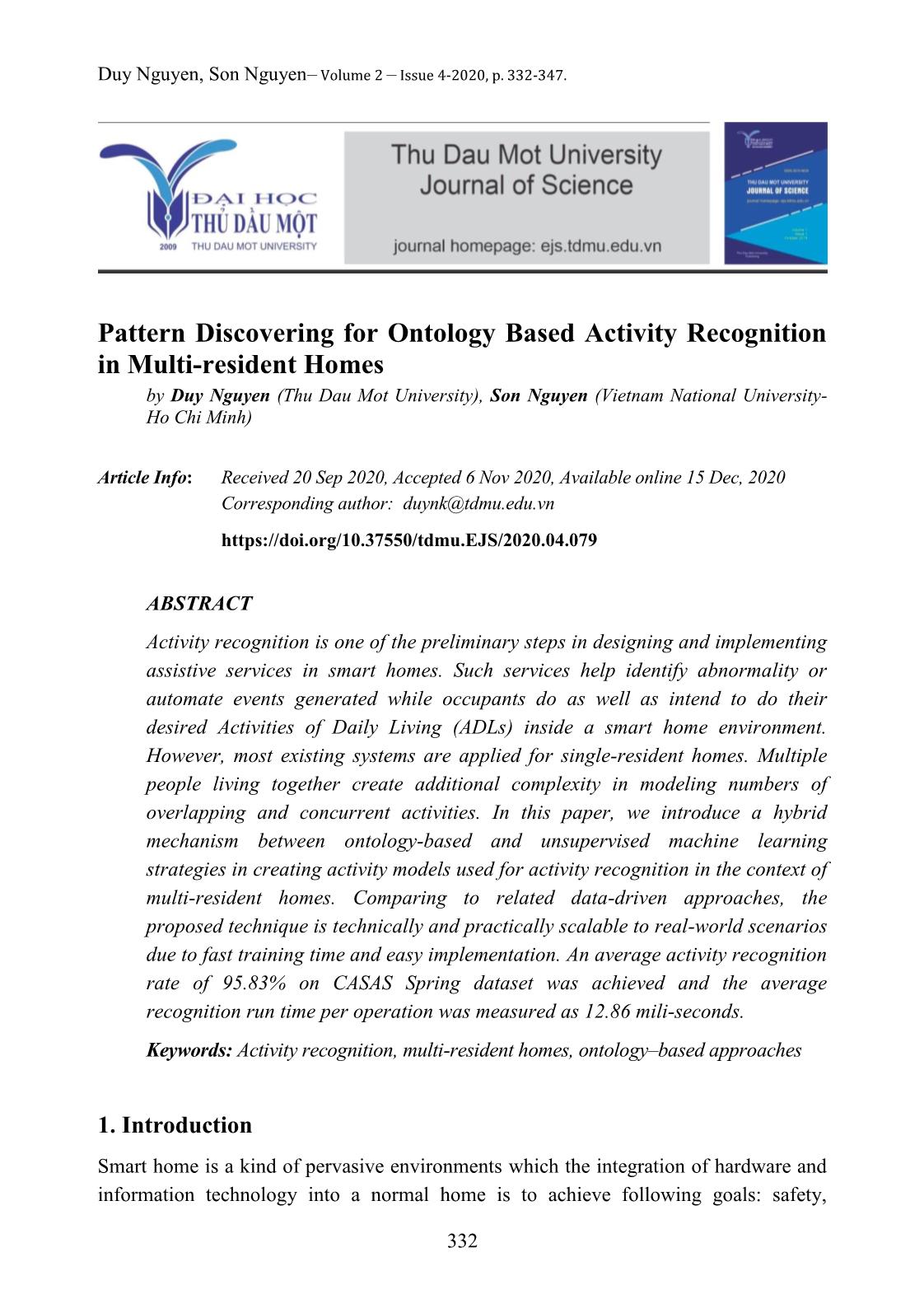
Trang 1
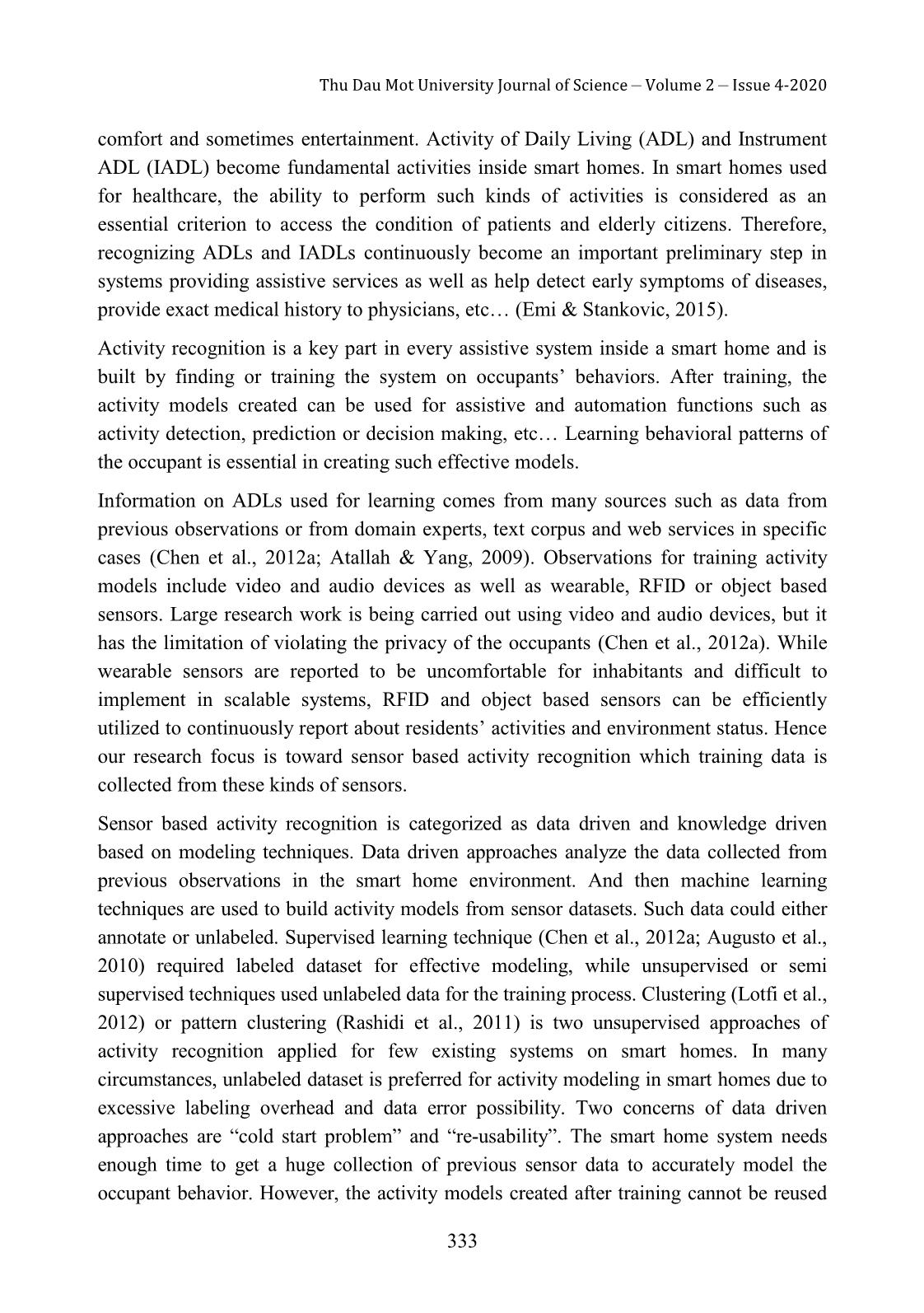
Trang 2
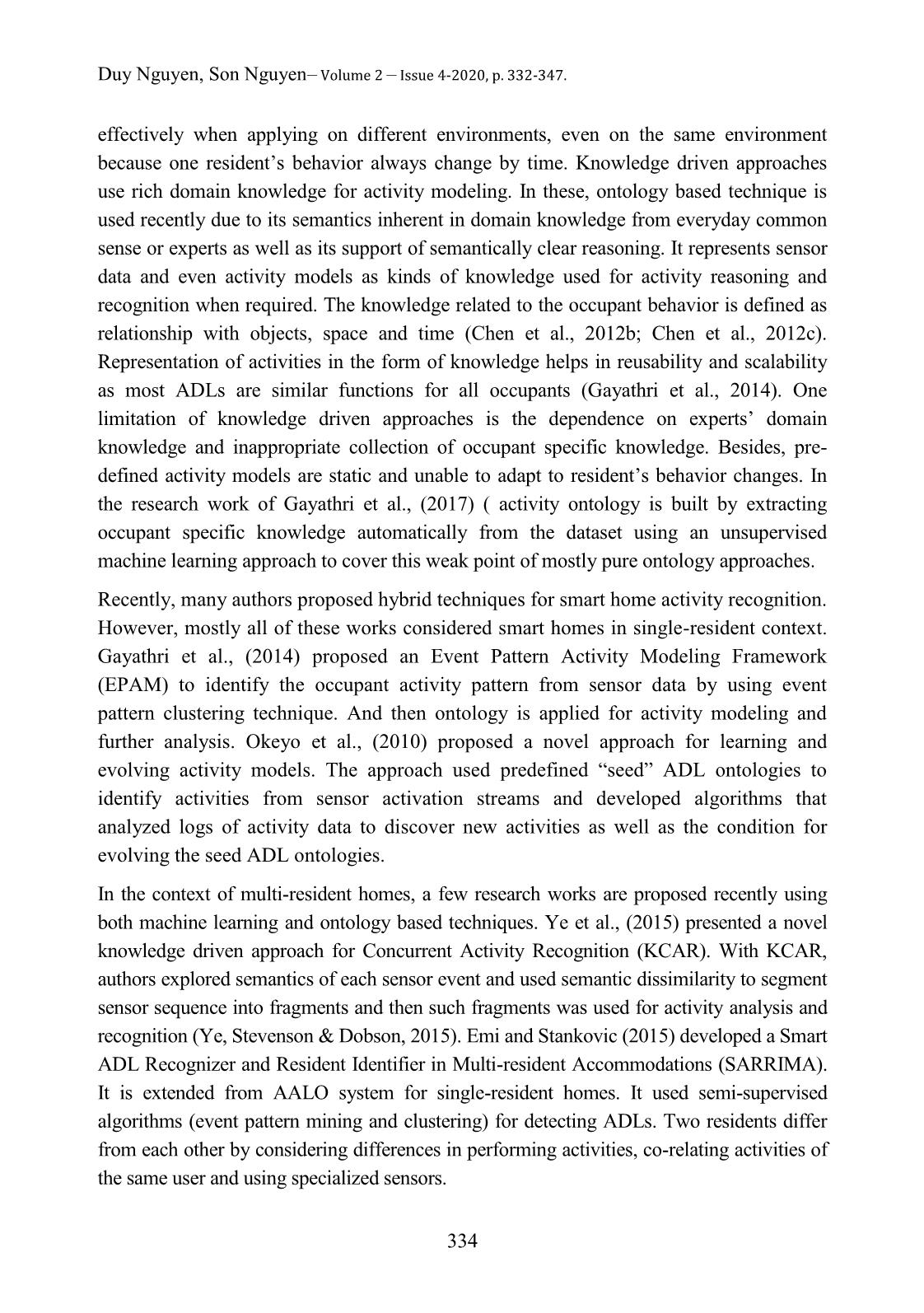
Trang 3
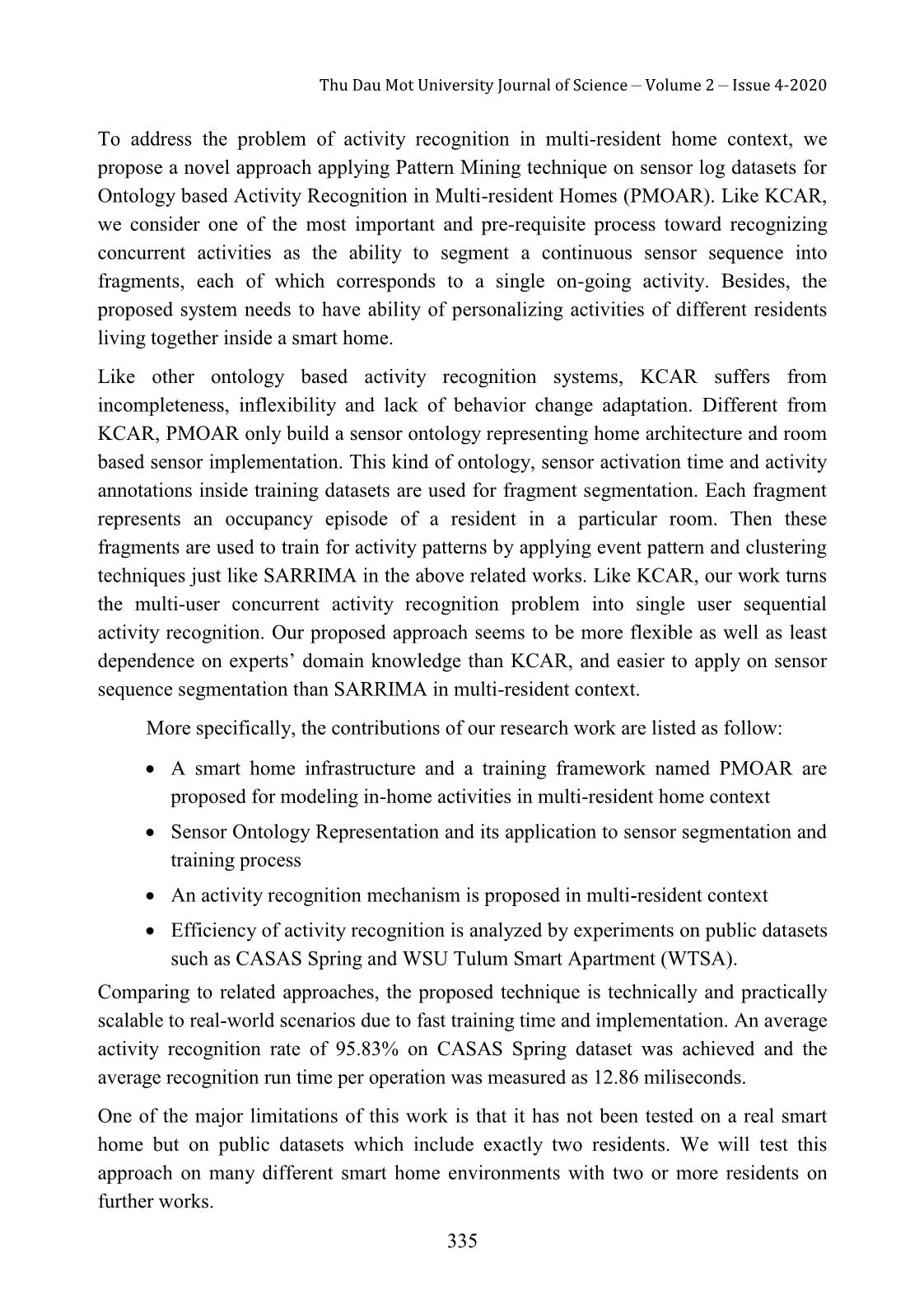
Trang 4
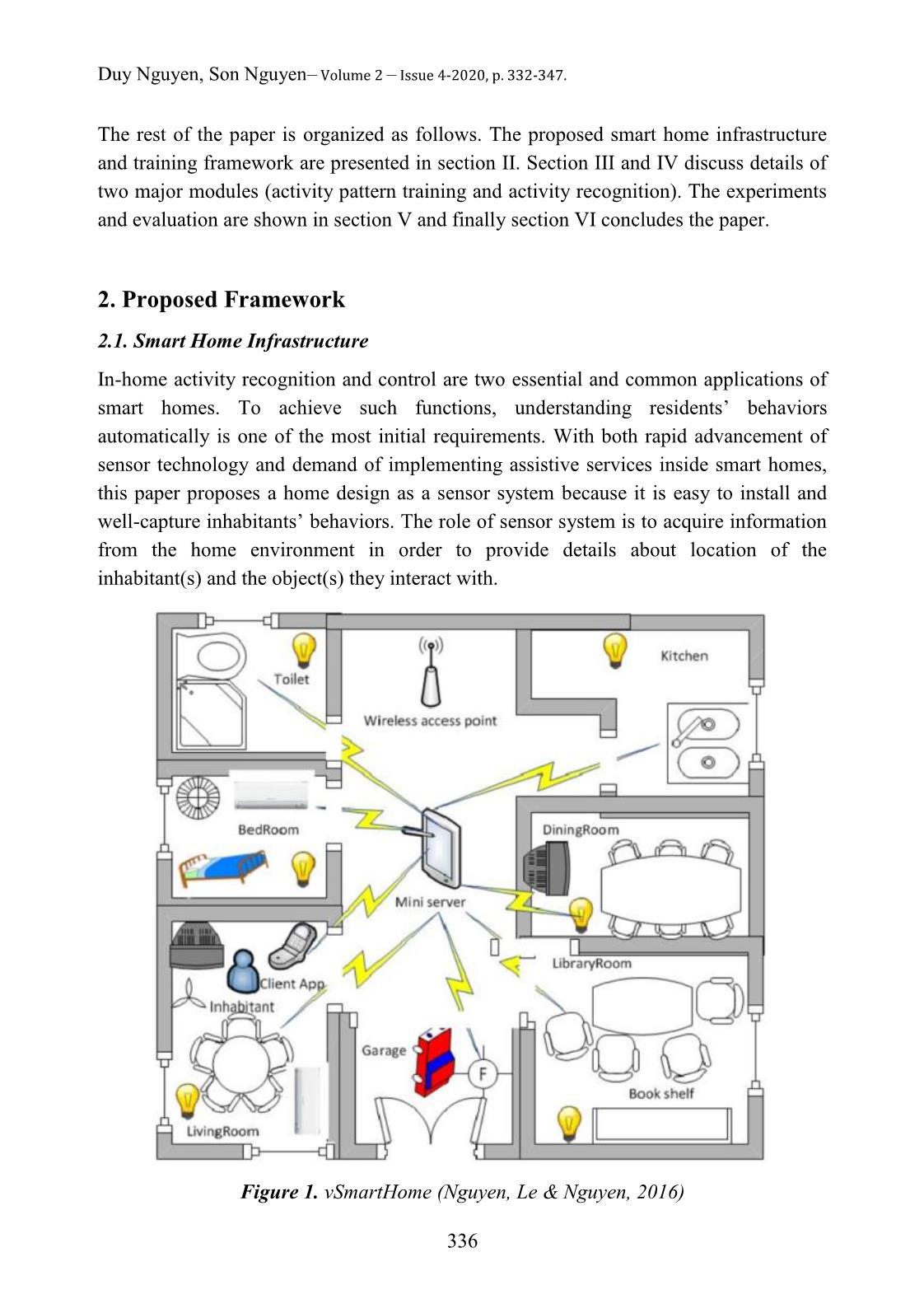
Trang 5
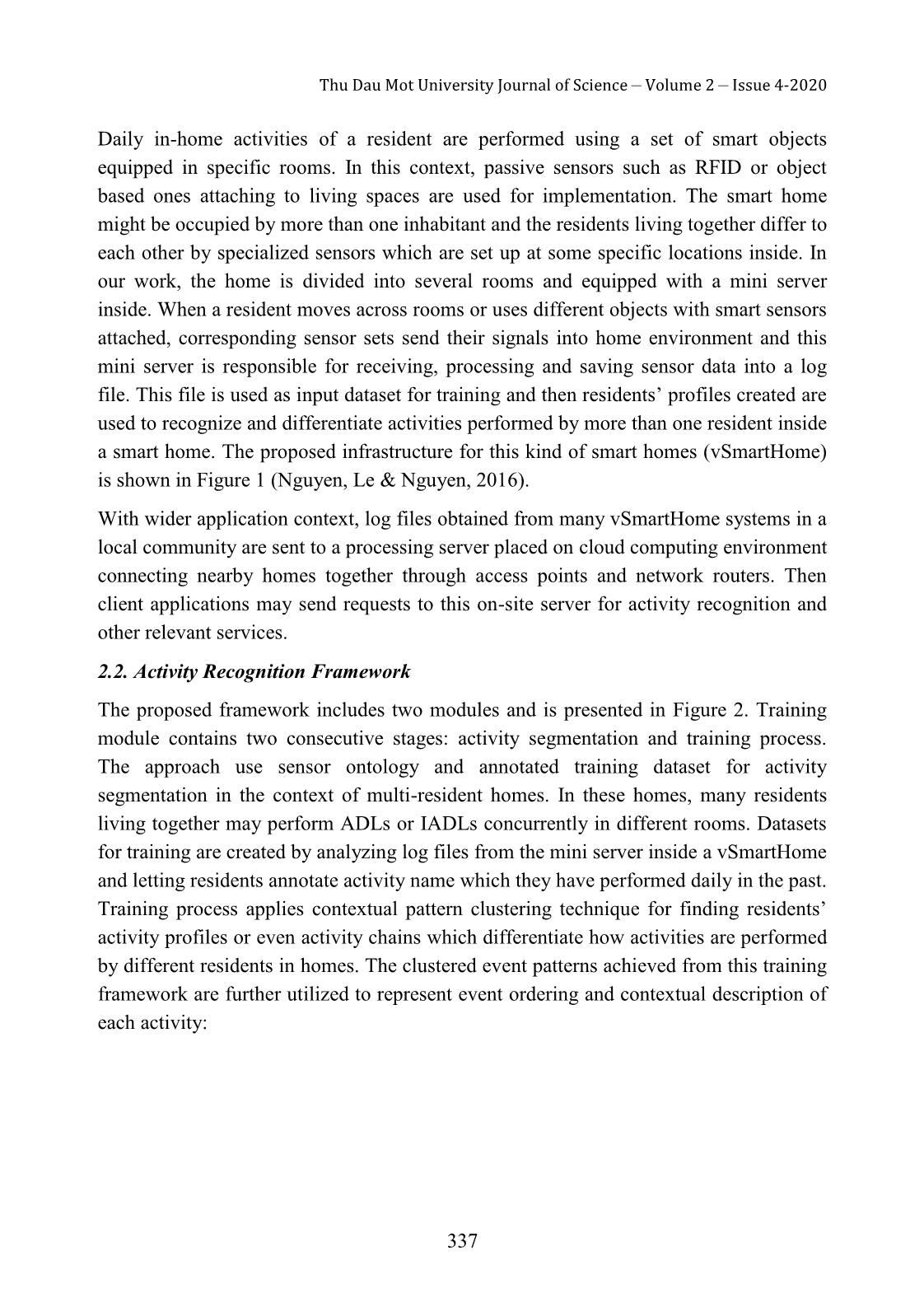
Trang 6
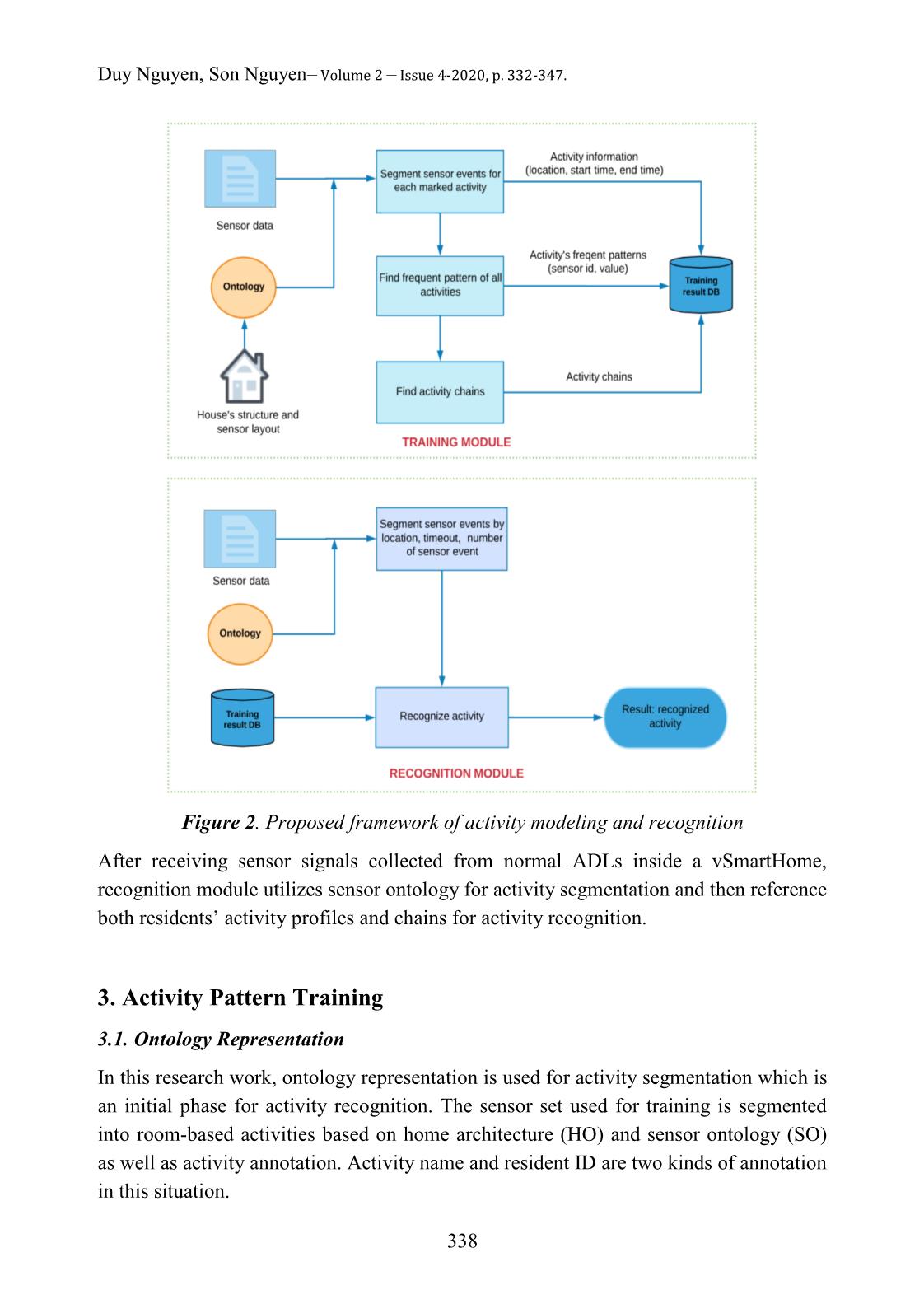
Trang 7
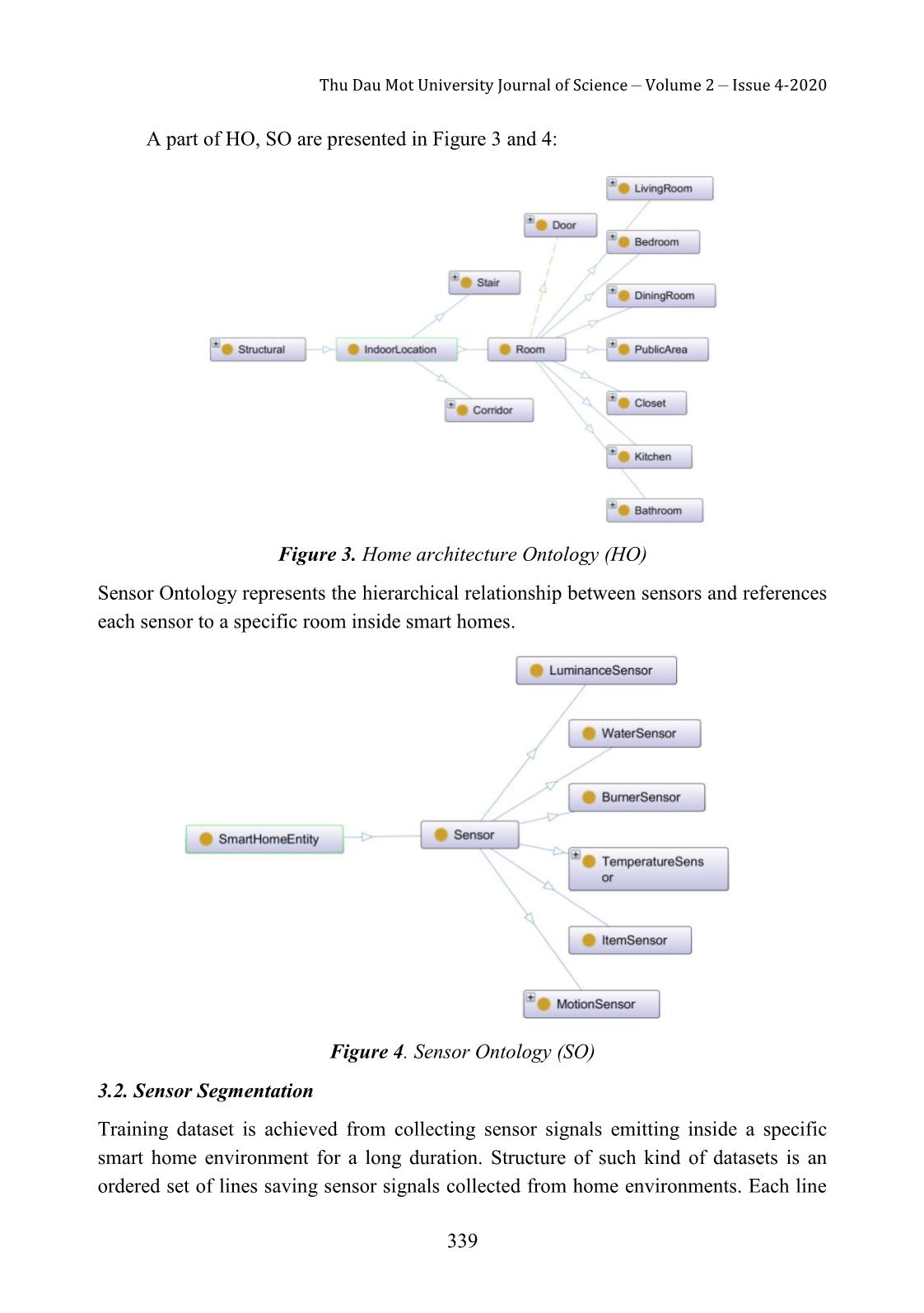
Trang 8
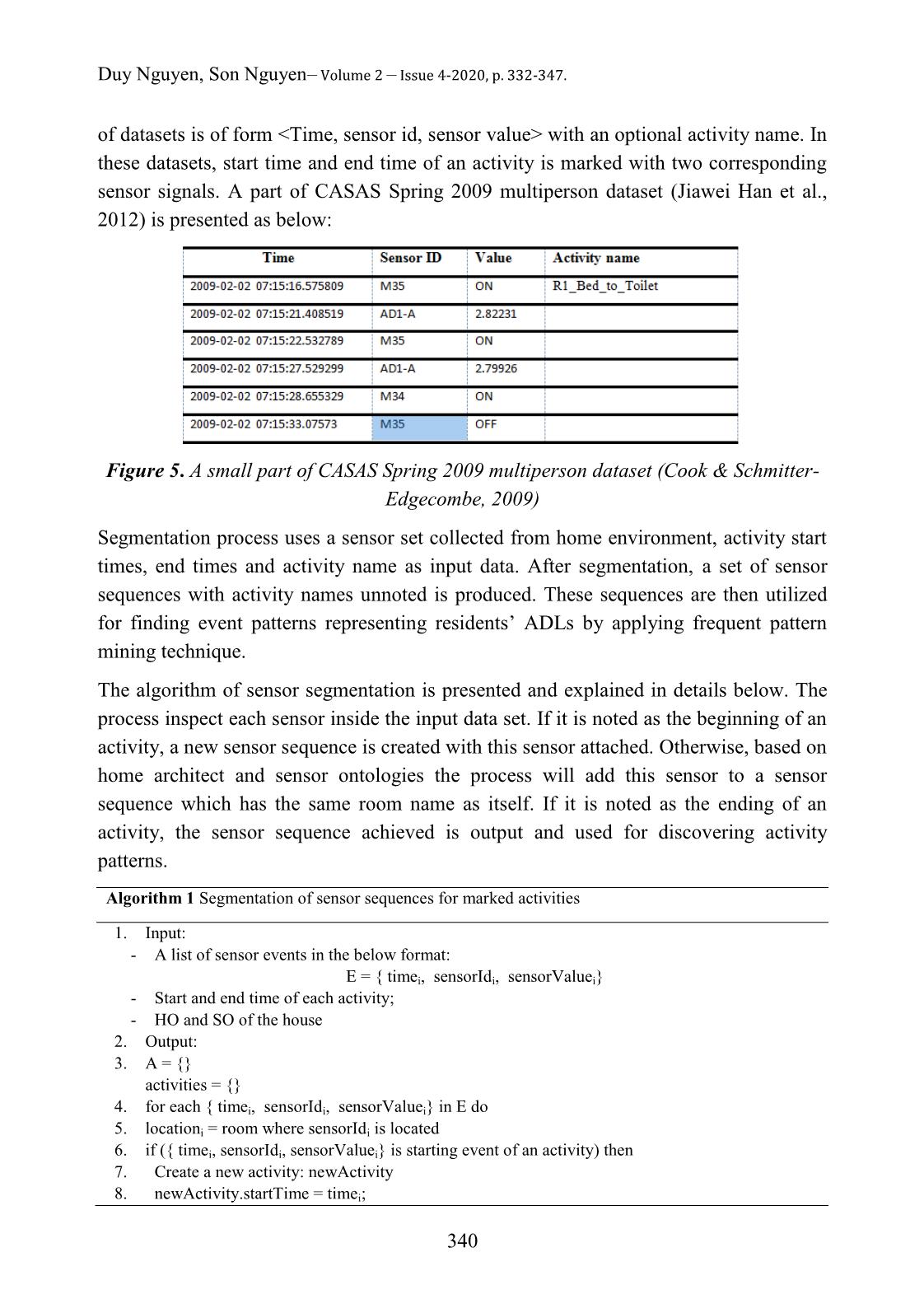
Trang 9
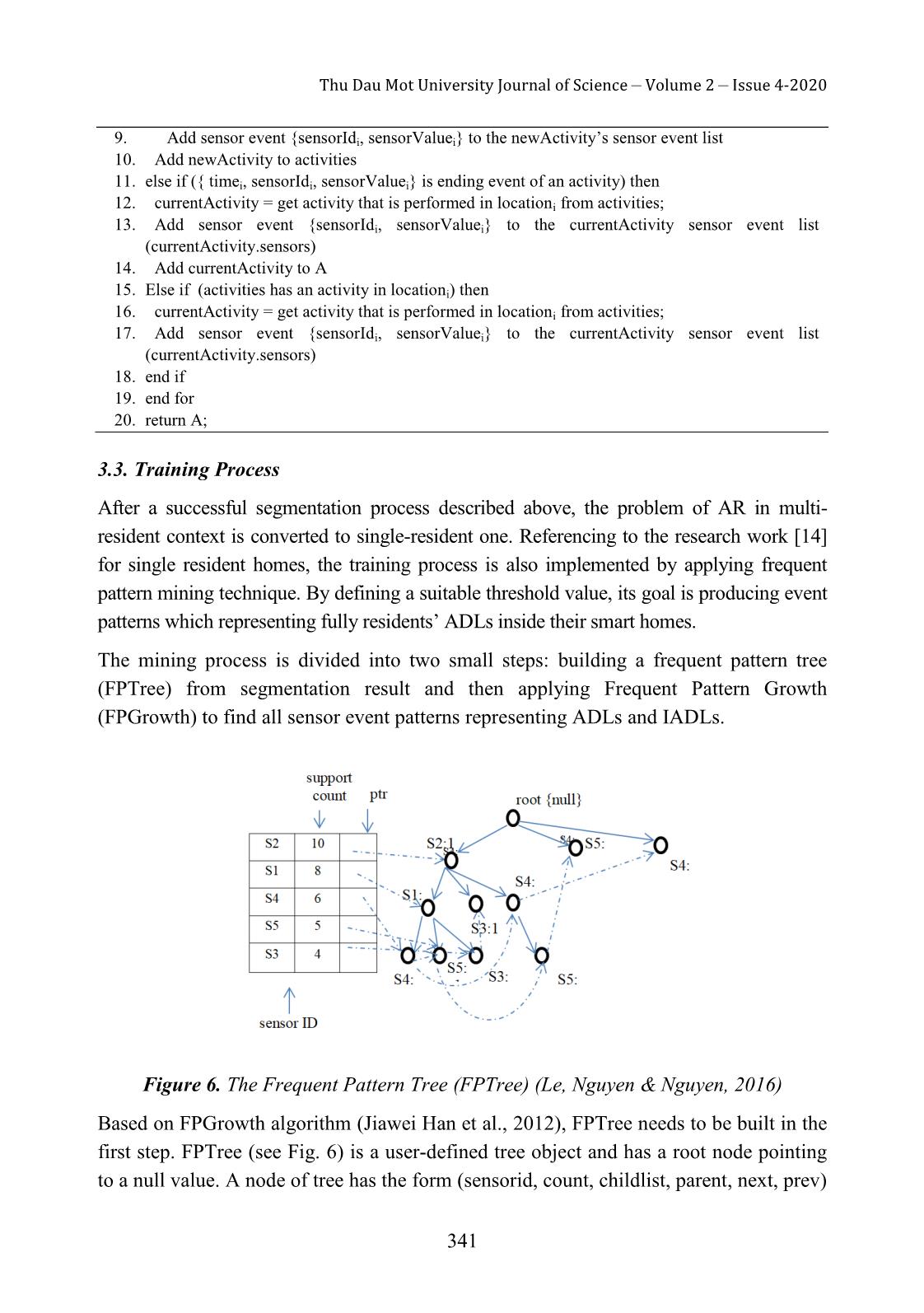
Trang 10
Tải về để xem bản đầy đủ
Tóm tắt nội dung tài liệu: Pattern discovering for ontology based activity recognition in multi-resident homes

Duy Nguyen, Son Nguyen– Volume 2 – Issue 4-2020, p. 332-347.
332
Pattern Discovering for Ontology Based Activity Recognition
in Multi-resident Homes
by Duy Nguyen (Thu Dau Mot University), Son Nguyen (Vietnam National University-
Ho Chi Minh)
Article Info: Received 20 Sep 2020, Accepted 6 Nov 2020, Available online 15 Dec, 2020
Corresponding author: duynk@tdmu.edu.vn
https://doi.org/10.37550/tdmu.EJS/2020.04.079
ABSTRACT
Activity recognition is one of the preliminary steps in designing and implementing
assistive services in smart homes. Such services help identify abnormality or
automate events generated while occupants do as well as intend to do their
desired Activities of Daily Living (ADLs) inside a smart home environment.
However, most existing systems are applied for single-resident homes. Multiple
people living together create additional complexity in modeling numbers of
overlapping and concurrent activities. In this paper, we introduce a hybrid
mechanism between ontology-based and unsupervised machine learning
strategies in creating activity models used for activity recognition in the context of
multi-resident homes. Comparing to related data-driven approaches, the
proposed technique is technically and practically scalable to real-world scenarios
due to fast training time and easy implementation. An average activity recognition
rate of 95.83% on CASAS Spring dataset was achieved and the average
recognition run time per operation was measured as 12.86 mili-seconds.
Keywords: Activity recognition, multi-resident homes, ontology–based approaches
1. Introduction
Smart home is a kind of pervasive environments which the integration of hardware and
information technology into a normal home is to achieve following goals: safety,
Thu Dau Mot University Journal of Science – Volume 2 – Issue 4-2020
333
comfort and sometimes entertainment. Activity of Daily Living (ADL) and Instrument
ADL (IADL) become fundamental activities inside smart homes. In smart homes used
for healthcare, the ability to perform such kinds of activities is considered as an
essential criterion to access the condition of patients and elderly citizens. Therefore,
recognizing ADLs and IADLs continuously become an important preliminary step in
systems providing assistive services as well as help detect early symptoms of diseases,
provide exact medical history to physicians, etc (Emi & Stankovic, 2015).
Activity recognition is a key part in every assistive system inside a smart home and is
built by finding or training the system on occupants’ behaviors. After training, the
activity models created can be used for assistive and automation functions such as
activity detection, prediction or decision making, etc Learning behavioral patterns of
the occupant is essential in creating such effective models.
Information on ADLs used for learning comes from many sources such as data from
previous observations or from domain experts, text corpus and web services in specific
cases (Chen et al., 2012a; Atallah & Yang, 2009). Observations for training activity
models include video and audio devices as well as wearable, RFID or object based
sensors. Large research work is being carried out using video and audio devices, but it
has the limitation of violating the privacy of the occupants (Chen et al., 2012a). While
wearable sensors are reported to be uncomfortable for inhabitants and difficult to
implement in scalable systems, RFID and object based sensors can be efficiently
utilized to continuously report about residents’ activities and environment status. Hence
our research focus is toward sensor based activity recognition which training data is
collected from these kinds of sensors.
Sensor based activity recognition is categorized as data driven and knowledge driven
based on modeling techniques. Data driven approaches analyze the data collected from
previous observations in the smart home environment. And then machine learning
techniques are used to build activity models from sensor datasets. Such data could either
annotate or unlabeled. Supervised learning technique (Chen et al., 2012a; Augusto et al.,
2010) required labeled dataset for effective modeling, while unsupervised or semi
supervised techniques used unlabeled data for the training process. Clustering (Lotfi et al.,
2012) or pattern clustering (Rashidi et al., 2011) is two unsupervised approaches of
activity recognition applied for few existing systems on smart homes. In many
circumstances, unlabeled dataset is preferred for activity modeling in smart homes due to
excessive labeling overhead and data error possibility. Two concerns of data driven
approaches are ―cold start problem‖ and ―re-usability‖. The smart home system needs
enough time to get a huge collection of previous sensor data to accurately model the
occupant behavior. However, the activity models creat ...
- Start and end time of each activity;
- HO and SO of the house
2. Output:
3. A = {}
activities = {}
4. for each { timei, sensorIdi, sensorValuei} in E do
5. locationi = room where sensorIdi is located
6. if ({ timei, sensorIdi, sensorValuei} is starting event of an activity) then
7. Create a new activity: newActivity
8. newActivity.startTime = timei;
Thu Dau Mot University Journal of Science – Volume 2 – Issue 4-2020
341
9. Add sensor event {sensorIdi, sensorValuei} to the newActivity’s sensor event list
10. Add newActivity to activities
11. else if ({ timei, sensorIdi, sensorValuei} is ending event of an activity) then
12. currentActivity = get activity that is performed in locationi from activities;
13. Add sensor event {sensorIdi, sensorValuei} to the currentActivity sensor event list
(currentActivity.sensors)
14. Add currentActivity to A
15. Else if (activities has an activity in locationi) then
16. currentActivity = get activity that is performed in locationi from activities;
17. Add sensor event {sensorIdi, sensorValuei} to the currentActivity sensor event list
(currentActivity.sensors)
18. end if
19. end for
20. return A;
3.3. Training Process
After a successful segmentation process described above, the problem of AR in multi-
resident context is converted to single-resident one. Referencing to the research work [14]
for single resident homes, the training process is also implemented by applying frequent
pattern mining technique. By defining a suitable threshold value, its goal is producing event
patterns which representing fully residents’ ADLs inside their smart homes.
The mining process is divided into two small steps: building a frequent pattern tree
(FPTree) from segmentation result and then applying Frequent Pattern Growth
(FPGrowth) to find all sensor event patterns representing ADLs and IADLs.
Figure 6. The Frequent Pattern Tree (FPTree) (Le, Nguyen & Nguyen, 2016)
Based on FPGrowth algorithm (Jiawei Han et al., 2012), FPTree needs to be built in the
first step. FPTree (see Fig. 6) is a user-defined tree object and has a root node pointing
to a null value. A node of tree has the form (sensorid, count, childlist, parent, next, prev)
Duy Nguyen, Son Nguyen– Volume 2 – Issue 4-2020, p. 332-347.
342
where sensorid is the unique id of each sensor, count is the number of times the sensor
broadcasts signals into home environment, childlist is the list of its child nodes, parent
point to its parent node, next and prev are the pointers pointing to other tree nodes
having the same sensor id on the FPTree.
Mining results are sensor event patterns which not only define contextual description of
ADLs but also differentiate behaviors of each resident by forming personal activity
profiles and summarizing activity chains done by an inhabitant on a daily basis.
4. Recognition Mechanism
When the mini server receives sensor signals, it will segment the sensor sequence based
on home architecture and sensor ontologies. Segmenting helps to recognize concurrent
activities taking place at different rooms at the same time and performing by different
residents living inside a smart home. If these sensor segments have enough a defined
number of sensor events or exceed a duration timeout, the system will utilize sensor
events inside each segment for activity recognition. This mechanism helps to recognize
continuously ADLs, even when a resident finish the previous activity and do another
one at the same room.
In general, recognition process contains two stages: 1) Sensor Segmentation; 2) Activity
Recognition
4.1. Sensor Segmentation
The input data are sensor event sequences produced inside smart home
environment, while each event may come from different locations and rooms. It
compares location of each sensor with the current room to decide for addition or new
segment creation. Besides, during segmentation process the system also tests conditions
for activity recognition. The process is depicted in the below algorithm:
Algorithm 2 Segmentation of sensor events
1. Input:
- sensorEvents: list of sensor events
- blockTime: maximum time of a segment
- maxSensorNumber: maximum sensor events of a segment
2. Output:
Segment of sensor events in a location that is input for activity recognition phase
3. Create a list:
activityThreads = {};
4. For each sensorEvent in sensorEvents then
sensorLocation = room where sensorIdi is located (query from ontology O)
5. If activityThreads has sensor event list that located in sensorLocation then
Thu Dau Mot University Journal of Science – Volume 2 – Issue 4-2020
343
6. sensorEventList = get sensor event list in currentlocation from activityThreads
7. Add sensorEvent to sensorEventList
8. If sensorEventList.size >= maxSensorNumber OR sensorEventList.lastEventDate -
sensorEventList.firstEventDate >= blockTime then
9. remove sensorEventList from activityThreads and start recognize activity of this sensor event list
10. End if;
11. Else new newSensorEventList, Add sensorEvent to newSensorEventList
12. Add newSensorEventList to activityThreads;
13. end if
14. end for
4.2. Activity Recognition
Sensor segments are used as input data for activity recognition. At the first stage,
the system compares segment content with event patterns saved inside activity clusters
or residents’ activity profiles. Activities having higher match level will be used as
results for recognition process. Besides, activity chains summarized after event pattern
clustering are further used to increase the exact level of recognition results.
Based on such chains, the system has ability to predict possible activities which
might take place after the recognized activity.
The algorithm below is depicted in details for this process:
Algorithm 3 Recognize activity
1. Input:
- Training result:
- activityPatterns: list of activities and sensor event patterns.
- activityChains: list of activity chain created by algorithm 2
- traningActivityList: list of all performed activities in training data
- sensorEvents: list of sensor event in a same location that is segmented in the algorithm 2
- location = location of sensorEvents
2. Output:
- Activity of the sensor event list
- Possible activity chain
3. Create:
//List of activity and match point of the activity with the sensorEvents
activityMatchingList = {};
4. Filter out elements in activityPatterns, traningActivityList and activityChains by time and
location to reduce the process time
5. For each activityPattern in activityPatterns then
6. Calculate matchPoint of sensorEvents based on activityPattern and
traningActivityList
Add activityPattern.activityName and matchPoint to activityMatchingList;
7. End for;
8. Sort activityMatchingList by matchPoint descending, filter out elements that low matchPoint
Duy Nguyen, Son Nguyen– Volume 2 – Issue 4-2020, p. 332-347.
344
9. Group same elements in activityChains and sort by appearances descending
10. For each activityMatching in activityMatchingList then
11. For each activityChain in activityChains then
12. If activityChain includes activityMatching then
Print activity information: name, location, and possible activity chain;
13. end if
14. end for
15. end for
5. Experiments And Evaluation
The efficiency of the proposed approach lies in two elements: fast training time and
easy implementation on a normal home with many rooms and more than one resident
occupied. The approach lies between knowledge-based and data-driven techniques. It
decreases at least the dependence of domain knowledge provided by experts. Besides,
performing ADLs may change by time due to resident’s habit or behavior changes.
Utilizing just kind of knowledge will make the smart home less flexible and slower for
adaptation. In addition, using home architecture and sensor ontologies helps to segment
sensor sequences easier coming from concurrent activities in the context of multi-
resident homes.
5.1. Experiments
There are few available multi-user datasets that are well annotated in the smart home
community. After a careful selection, we choose a public dataset from the CASAS
Smart Home project (Cook & Schmitter-Edgecombe, 2009) used for experiments. In
this paper, we included performance results of the proposed approach in the ―CASAS
Spring 2009 multiperson dataset‖ (see Figure 7). In this dataset, data was collected from
a two-story apartment that housed two residents and they performed their normal daily
activities. The ground floor includes kitchen, two small rooms and stairs. The second
floor includes two bedrooms, one toilet and an empty room. The dataset annotates
several ADLs such as sleeping, personal hygiene, preparing meal, work, study and
watching TV. Seventy-two sensors are deployed in the house including motion, item,
door/contact and temperature sensors (Emi & Stankovic, 2015).
The two-month dataset is divided into 2 parts: 1 month and 22 days used for training
and the rest of 10 days for recognition.
5.2. Evaluation
Training duration on the computer running Windows 10 Pro with CPU Intel Core i3-
8100 (6M Cache, 3,60 GHz) and RAM 8GB is 13.485ms.
Thu Dau Mot University Journal of Science – Volume 2 – Issue 4-2020
345
Figure 7. CASAS Spring Sensor Deployment (Cook & Schmitter-Edgecombe, 2009)
Accuracy percentage of activity recognition is measured for 4 ADLs and presented in
the below table:
TABLE 1. Accuracy percentage of the proposed system
Activity Name Number of sensor segments Accuracy
Work 99 97.98%
Preparing meal 67 97.01%
Sleeping 335 99.403%
Personal hygiene 107 87.06%
Accuracy average 95.83%
The proposed approach is proved to have the same accuracy rating with the SARRIMA
system (Emi & Stankovic, 2015), while it is technically and practically scalable to real-
world scenarios due to fast training time and easier in implementation. Home
architecture and sensor network of a smart home are known in advance. In multi-resident
context with many concurrent activities, two corresponding kinds of ontology help to
segment sensor streams into inhabitants’ activity instances easier. Besides, experiment
results show that duration of each activity recognition is measured about 1ms. It is fast
enough for implementing real-time activity recognition.
6. Conclusion
Smart home offers assistive services through modeling activity recognition system. The
proposed approach of activity modeling and recognition combines strong points of
knowledge-based and data-driven techniques. In this work, we just use ontologies to
Duy Nguyen, Son Nguyen– Volume 2 – Issue 4-2020, p. 332-347.
346
segment sensor sequences for solving the problem of concurrent activities in multi-
resident context. Then we apply pattern mining technique for modeling activities. Such
models produced are proved more flexible and adaptable to behavior changes of residents
as well as depend at least to experts’ knowledge. Residents’ habit or behaviors always
changes by time due to many factors. Therefore, letting the smart home system more and
more flexible to changes is very important. After a defined duration, the system needs
ability of refreshing activity models by re-training. In the future, we will implement the
proposed system in other smart home environments and looking for re-training conditions
necessary to deploy a real smart home system efficiently for a long time.
References
Atallah, L., Yang, G.-Z. (2009). The use of pervasive sensing for behavior profiling—a survey.
Pervasive Mob. Comput. 5(5), 447–464.
Augusto, J.C., Nakashima, H., Aghajan, H. (2010). Ambient intelligence and smart
environments: a state of the art. In: Handbook of Ambient Intelligence and Smart
Environments, 3–31.
Aztiria, A., Izaguirre, A., Augusto, J.C. (2010). Learning patterns in ambient intelligence
environments: a survey. Artif. Intell. Rev. 34(1), 35–51. Springer, Netherlands.
Chen, L., Hoey, J., Nugent, C.D., Cook, D.J., Zhiwen, Y. (2012a). Sensor-based activity
recognition. IEEE Trans. Syst. Man Cybern. Part C 42(6), 790–808.
Chen, L., Hoey, J., Nugent, C.D., Cook, D.J., Zhiwen, Y. (2012b). Sensor-based activity
recognition. IEEE Trans. Syst. Man Cybern. Part C 42(6), 790–808
Chen, L., Nugent, C.D., Wang, H. (2012c). A knowledge-driven approach to activity
recognition in smart homes. IEEE Trans. Knowl. Data Eng. 24(6), 961–974.
D Nguyen, T Le, S Nguyen (2016). A Novel Approach to Clustering Activities within Sensor
Smart Homes. The International Journal of Simulation Systems, Science & Technology.
D. J. Cook, M. Schmitter-Edgecombe (2009). Assessing the quality of activities in a smart
environment. Methods Inf Med, 48(5),480–485.
G Okeyo, L Chen, H Wang, R Sterritt (2010). Ontology-enabled activity learning and model
evolution in smart home. The International Conference on Ubiquitous Intelligence and
Computing, pp. 67-82.
IA Emi, JA Stankovic (2015). SARRIMA: a smart ADL recognizer and resident identifier in
multi-resident accommodations. In Proceedings of the Conference on Wireless Health
(Bethesda, Maryland — October 14 - 16, 2015). ISBN: 978-1-4503-3851-6
J Ye, G Stevenson, S Dobson (2015). KCAR: A knowledge-driven approach for concurrent
activity recognition. Pervasive and Mobile Computing (May 2015), vol 15, 47-70.
Jiawei Han, Micheline Kamber, and Jian Pei (2012), Mining Frequent Patterns, Associations
and Correlations: Basic Concepts and Methods, in Data Mining: Concepts and Techniques,
3rd edition, 243 – 278.
Thu Dau Mot University Journal of Science – Volume 2 – Issue 4-2020
347
KS Gayathri, KS Easwarakumar, S Elias (2017). Contextual Pattern Clustering for Ontology
Based Activity Recognition in Smart Home. The International Conference on Intelligent
Information Technologies (17 December 2017)
KS Gayathri, S Elias, S Shivashankar (2014). An Ontology and Pattern Clustering Approach for
Activity Recognition in Smart Environments. In Proceedings of Advances in Intelligent
Systems and Computing (04 March 2014)
Lotfi, A., Langensiepen, C.S., Mahmoud, S.M., Akhlaghinia, M.J. 2012: Smart homes for the
elderly dementia sufferers: identification and prediction of abnormal behaviour. J. Ambient
Intell. Humaniz. Comput. 3(3), 205–218
Rashidi, P., Cook, D.J., Holder, L.B., Schmitter-Edgecombe, M. J (2011): Discovering activities
to recognize and track in a smart environment. IEEE Trans. Knowl. Data Eng. 23(4), 527–
539.
T Le, D Nguyen, S Nguyen (2016). An approach of using in-home contexts for activity
recognition and forecast. In Proceedings of the 2nd International Conference on Control,
Automation and Robotics, ISBN: 978-1-4673-8702-6, pp. 182-186
File đính kèm:
 pattern_discovering_for_ontology_based_activity_recognition.pdf
pattern_discovering_for_ontology_based_activity_recognition.pdf

